 Over the weekend, Republican Sen. Lisa Murkowski announced she would run as a write-in candidate this November after reportedly losing a close GOP primary race to far Rightwing "Tea Party" candidate Joe Miller.
Over the weekend, Republican Sen. Lisa Murkowski announced she would run as a write-in candidate this November after reportedly losing a close GOP primary race to far Rightwing "Tea Party" candidate Joe Miller.
The three-way race, along with Democratic candidate and Mayor of Sitka Scott McAdams, could prove to be a serious challenge for Alaska's historically-dicey optical-scan voting system made by Diebold. Given the shortcomings of the system which otherwise employs the concealed vote-counting of centrally tabulated ballots, the need to hand-review write-in votes this November could present a unique opportunity for citizens of the 49th state to oversee at least some of their own electoral system --- for a welcome change.
Statistical polling analyst Nate Silver, whose FiveThirtyEight blog is now hosted by The New York Times, has been suggesting that Murkowski's seemingly-Quixotic bid, while still a long shot, may actually prove to be "viable" as a write-in campaign. But whether or not Alaska's voting system is up to task may be a different matter, and an additional hurtle for Murkowski to overcome...
 By way of full disclosure, I spent many hours on the phone with Alaska Democratic officials and election integrity advocates alike when they sought my advice on how to fight for transparency and oversight after the 2008 election in the wake of two extremely close high profile races. The discussion centered on oversight, and potential court action that might be required to achieve it, for the state's centrally-counted, paper-based, optical-scan systems made by Diebold Election Systems, Inc. (which has recently been purchased by the Canadian firm Dominion Voting)
By way of full disclosure, I spent many hours on the phone with Alaska Democratic officials and election integrity advocates alike when they sought my advice on how to fight for transparency and oversight after the 2008 election in the wake of two extremely close high profile races. The discussion centered on oversight, and potential court action that might be required to achieve it, for the state's centrally-counted, paper-based, optical-scan systems made by Diebold Election Systems, Inc. (which has recently been purchased by the Canadian firm Dominion Voting)
The two races still in question at the time were between incumbent Sen. Ted Stevens (R) and Mark Begich (D), who was eventually announced the winner after Stevens' concession, and between Rep. Don Young (R) and his then-challenger Ethan Berkowitz, whom I spoke with at some length, encouraging him to demand a hand count of all ballots cast in the race and a forensic examination of the error-prone, and easily-manipulated tabulation system. Berkowitz declined my advice and ended up conceding without a hand-count or technical investigation. (Berkowitz, a state representative, will be on the ballot again this year, in his challenge to incumbent Republican Gov. Sean Parnell.)
Happily, Alaska claims to judge ballots on whether "voter intent" can be determined. But determining "voter intent," if not done transparently, can also be influenced by political bias. In this case, according to AP, the election will be overseen by Lt. Gov. Craig Campbell, who was appointed to that job when, as Sarah Palin's Lt. Gov., Parnell ascended to the Governorship following her resignation last year. Palin's own preference in the Senate race is already on record as a supporter and endorser of Miller against Murkowski. The rivalry between Palin and the Murkowski goes back some ways as Lisa became Senator after being appointed to the job by her father who vacated the post to become the state's Governor. In the following election, the elder Murkowski was unseated by Palin, who went on to win the general election, in the GOP primary.
So, in his role of overseer of the election, the appointed-Lt. Gov. of Palin's former Lt. Gov. has told AP that merely writing in "Lisa" would not be enough to tally the vote in favor of Murkowski, despite what would seem to be the voter's clear "intent" in writing in that name on the ballot for U.S. Senate.
In highly contentious races, as we've seen over the last several years, at least in races controlled by Republicans, the partisan politics of those in ultimate control of the counting often overrides the more (small "d") democratic notion of "voter intent." You'll recall ballots were discounted during the 2000 Presidential race where Al Gore's name had been both punched and written in specifically to the write-in slot. Clearly the voter's intent had been for Gore, but partisan politicians fought to discount such ballots on the basis that voting rules hadn't been followed when "two" selections were made (one for Gore in his printed position, and again for Gore in the write-in position on the ballot).
In an election which may prove to offer even more direct parallels to the Murkowski-Miller-McAdams race, surf-shop owner Donna Frye was said to have won a plurality of votes during her write-in campaign on Diebold optical-scan systems in the 2004 race for San Diego Mayor. However, the hard-right Republican election officials in the county refused to count ballots where voters had written in Frye's name, but failed to fill in the bubble next to it. As well, the intent of voters who had spelled her name as "Fry" instead of "Frye," was similarly disregarded and Republican Dick Murphy was eventually declared the victor.
Alaska's election officials, it seems, will also require that voters both write-in their preference and fill-in the oval next to it. AP reports that, according to AK Lt. Gov. Campbell,...
...
The director of the state Division of Elections had said Murkowski's name would not need to be spelled correctly if voter intent could be ascertained.
How the state's claim to judge ballots by a "voter intent" standard squares with notion of votes being discounted when only the name "Lisa" is written into the write-in slot, or when voters wrote in the full name but failed to fill-in the oval, is not clear.
In the NYTimes today, Silver poses a few of the questions which we all may have to revisit on November 2nd (and 3rd and 4th and beyond), should the Diebold-reported AK Senate race appear to be close...
In addition to still-open questions about how (and if) ballots will be counted --- an issue apparently to be determined, (hopefully before the race) by those disposed to support Miller over Murkowski (and certainly over the Democrat McAdams) --- chain of custody issues could also come into play in the race, as the state's ballots are all centrally counted in Anchorage after being shipped in from the far reaches of Alaska's many remote areas and islands. It's not unusual for hours, and sometimes even days, to pass before all ballots are accounted for at "Elections Central" in Anchorage.
It's also unclear, at least to me at this time, what the procedure will be for counting write-ins at all. The notoriously inaccurate and hackable Diebold op-scan system does not read hand-writing directly, though it would attempt to read whether or not the oval for a "Write-in" candidate has been filled in by the voter.
At that point, actual human beings would have to review the ballots in question to determine which name has been specified by the voter as their write-in preference.
Actual human beings, actually reviewing ballots to determine voter intent, is a very good thing --- presuming the process is a transparent one, such as we saw during the very well-run hand-count of the 2008 U.S. Senate race in Minnesota between Norm Coleman and Al Franken, when the review was done by members of all parties and open to citizen review and video cameras.
As the Diebold systems historically and notoriously fail to count certain ballots at all in many cases --- even those which don't have a write-in preference on them --- hopefully all of the ballots will be reviewed carefully by all parties and by the citizenry in the bargain. Hand-counted paper ballots are, of course, "Democracy's Gold Standard" when it comes to close elections, begging the question of why, in general, that process is used only when we really really really need to know who won an election, but in all other elections, as e-voting proponents will claim without evidence, "human beings are far less accurate than machines."
I suspect we may have to revisit this issue, with more specifics, in the weeks and (perhaps) months ahead as things move forward, but I thought you'd be interested in the general lay of the land, as we see it now, and as we head towards November in what will undoubtedly be a maddeningly interesting mid-term election.
UPDATE 9/20/10: Paul Gronke of the non-partisan Early Voting Information Center sees the possibility of a mess in Alaska and offers an ominous warning to boot:
...
If you're an election lawyer or election law/admin scholar, it might be good to clear your calendar for two weeks after Nov. 2.


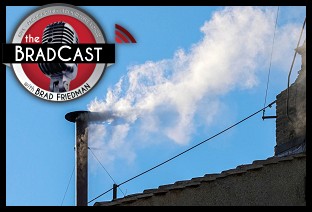 Blowing Smoke.
Blowing Smoke. 'Green News Report' 5/6/25
'Green News Report' 5/6/25
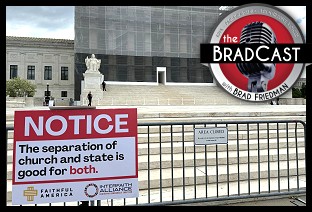 SCOTUS Allowing Publicly-Funded Religious Schools 'Would be a Ground-Breaking Disaster': 'BradCast' 5/7/25
SCOTUS Allowing Publicly-Funded Religious Schools 'Would be a Ground-Breaking Disaster': 'BradCast' 5/7/25 Trump Judge Blocks NC GOP Attempt to Steal 2024 State Supreme Court Election: 'BradCast' 5/6/25
Trump Judge Blocks NC GOP Attempt to Steal 2024 State Supreme Court Election: 'BradCast' 5/6/25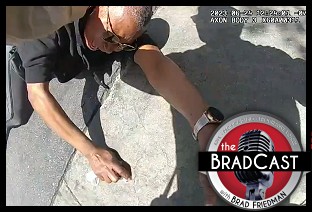 Prosecutors Resign After Trump U.S. Attny Strikes Deal With Felon Cop: 'BradCast' 5/5/25
Prosecutors Resign After Trump U.S. Attny Strikes Deal With Felon Cop: 'BradCast' 5/5/25 Sunday 'Good Buy, Dolly!' Toons
Sunday 'Good Buy, Dolly!' Toons Trump Losing Streak Continues into SECOND Hundred Days: 'BradCast' 5/1/25
Trump Losing Streak Continues into SECOND Hundred Days: 'BradCast' 5/1/25 'Green News Report' 5/1/25
'Green News Report' 5/1/25 100 Daze: 'BradCast' 4/30/25
100 Daze: 'BradCast' 4/30/25 Campaign to 'Impeach Trump Again' Gains Fresh Momentum: 'BradCast' 4/29/25
Campaign to 'Impeach Trump Again' Gains Fresh Momentum: 'BradCast' 4/29/25 'Green News Report' 4/29/25
'Green News Report' 4/29/25 And Then They Came for the Judges...: 'BradCast' 4/28/25
And Then They Came for the Judges...: 'BradCast' 4/28/25 Sunday 'Desperation' Toons
Sunday 'Desperation' Toons Trump EPA Guts Enviro Justice Office: 'BradCast' 4/24/25
Trump EPA Guts Enviro Justice Office: 'BradCast' 4/24/25 'Green News Report' 4/24/25
'Green News Report' 4/24/25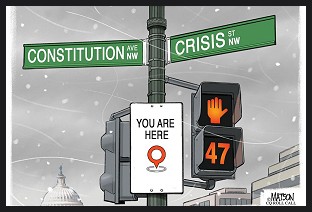 Sunday
Sunday  Largest U.S. Broad-caster Hoaxes Viewers to Help Gut FCC Rules: 'BradCast' 4/23/25
Largest U.S. Broad-caster Hoaxes Viewers to Help Gut FCC Rules: 'BradCast' 4/23/25 FCC on Precipice of Ending All Limits on Corp. Control of Local TV Stations
FCC on Precipice of Ending All Limits on Corp. Control of Local TV Stations GOP Earth Day 2025 Hypocrisies and Dilemmas: 'BradCast' 4/22/25
GOP Earth Day 2025 Hypocrisies and Dilemmas: 'BradCast' 4/22/25 Pope Francis Dies, Trump Still Alive and Criming: 'BradCast' 4/21/25
Pope Francis Dies, Trump Still Alive and Criming: 'BradCast' 4/21/25 Soc. Sec. Expert Warns DOGE of Collapse, Privatization: 'BradCast' 4/10/2025
Soc. Sec. Expert Warns DOGE of Collapse, Privatization: 'BradCast' 4/10/2025 Trump Blinks, Chaos Reigns, Markets Spike Amid Tariff 'Pause': 'BradCast' 4/9/25
Trump Blinks, Chaos Reigns, Markets Spike Amid Tariff 'Pause': 'BradCast' 4/9/25 SCOTUS Deportation Ruling Grimmer Than First Appears: 'BradCast' 4/8/25
SCOTUS Deportation Ruling Grimmer Than First Appears: 'BradCast' 4/8/25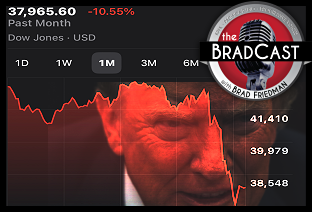 Cliff Diving with Donald: 'BradCast' 4/7/25
Cliff Diving with Donald: 'BradCast' 4/7/25
 VA GOP VOTER REG FRAUDSTER OFF HOOK
VA GOP VOTER REG FRAUDSTER OFF HOOK Criminal GOP Voter Registration Fraud Probe Expanding in VA
Criminal GOP Voter Registration Fraud Probe Expanding in VA DOJ PROBE SOUGHT AFTER VA ARREST
DOJ PROBE SOUGHT AFTER VA ARREST Arrest in VA: GOP Voter Reg Scandal Widens
Arrest in VA: GOP Voter Reg Scandal Widens ALL TOGETHER: ROVE, SPROUL, KOCHS, RNC
ALL TOGETHER: ROVE, SPROUL, KOCHS, RNC LATimes: RNC's 'Fired' Sproul Working for Repubs in 'as Many as 30 States'
LATimes: RNC's 'Fired' Sproul Working for Repubs in 'as Many as 30 States' 'Fired' Sproul Group 'Cloned', Still Working for Republicans in At Least 10 States
'Fired' Sproul Group 'Cloned', Still Working for Republicans in At Least 10 States FINALLY: FOX ON GOP REG FRAUD SCANDAL
FINALLY: FOX ON GOP REG FRAUD SCANDAL COLORADO FOLLOWS FLORIDA WITH GOP CRIMINAL INVESTIGATION
COLORADO FOLLOWS FLORIDA WITH GOP CRIMINAL INVESTIGATION CRIMINAL PROBE LAUNCHED INTO GOP VOTER REGISTRATION FRAUD SCANDAL IN FL
CRIMINAL PROBE LAUNCHED INTO GOP VOTER REGISTRATION FRAUD SCANDAL IN FL Brad Breaks PA Photo ID & GOP Registration Fraud Scandal News on Hartmann TV
Brad Breaks PA Photo ID & GOP Registration Fraud Scandal News on Hartmann TV  CAUGHT ON TAPE: COORDINATED NATIONWIDE GOP VOTER REG SCAM
CAUGHT ON TAPE: COORDINATED NATIONWIDE GOP VOTER REG SCAM CRIMINAL ELECTION FRAUD COMPLAINT FILED AGAINST GOP 'FRAUD' FIRM
CRIMINAL ELECTION FRAUD COMPLAINT FILED AGAINST GOP 'FRAUD' FIRM RICK SCOTT GETS ROLLED IN GOP REGISTRATION FRAUD SCANDAL
RICK SCOTT GETS ROLLED IN GOP REGISTRATION FRAUD SCANDAL VIDEO: Brad Breaks GOP Reg Fraud Scandal on Hartmann TV
VIDEO: Brad Breaks GOP Reg Fraud Scandal on Hartmann TV RNC FIRES NATIONAL VOTER REGISTRATION FIRM FOR FRAUD
RNC FIRES NATIONAL VOTER REGISTRATION FIRM FOR FRAUD EXCLUSIVE: Intvw w/ FL Official Who First Discovered GOP Reg Fraud
EXCLUSIVE: Intvw w/ FL Official Who First Discovered GOP Reg Fraud GOP REGISTRATION FRAUD FOUND IN FL
GOP REGISTRATION FRAUD FOUND IN FL

































